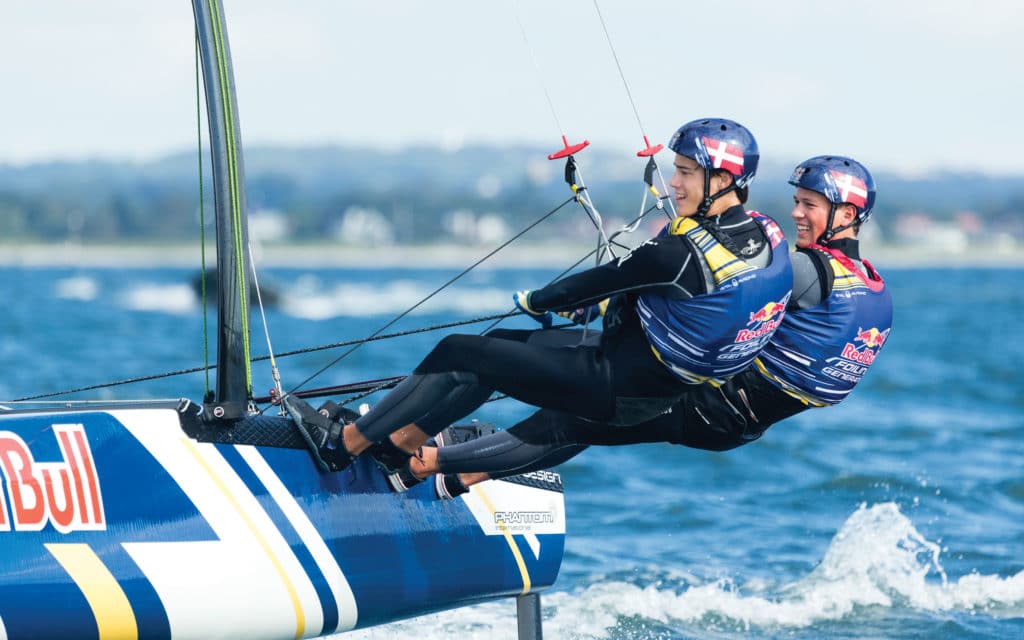
With the transition of the America’s Cup from monohulls to foiling catamarans, there’s a new pathway to sailing’s pinnacle event for young, high-performance sailors. It’s a steep and narrow switchback, however, given that most skills learned in dinghy or keelboat sailing don’t translate to foiling cats. So what’s a young wannabe professional foiler to do?
Enter the Red Bull Foiling Generation.
The program was created with the aim of softening transitional speed bumps to foil sailing, and its Austrian founders Roman Hagara and Hans-Peter Steinacher are recruiting youth sailors and introducing them to the thrill of foiling. With Olympic gold medals and countless world titles as credentials, Hagara and Steinacher simply want to give the youth “something else,” an alternative path to new forms of racing.
They’re using the Flying Phantom — an 18-foot double-trapeze foiling catamaran — as their training platform of choice for sailors ages 16 to 20. In 2015, they held events in Japan, the U.K., Italy, Sweden, Denmark, Russia and France, where select sailors spent three days getting a feel for the boat and two days racing. Champions from each event will face off at a regatta in 2016. In the grand scheme of things, says Hagara, the goal is “to support youth sailors all over the world and give them a chance to get into professional sailing.” He and Steinacher hope to round up the “best of the best” and funnel them toward racing in the Red Bull Youth America’s Cup in 2017.
The campaign has so far accomplished one primary goal: leading talented young sailors to the path. But one of Hagara’s concerns is whether five days is enough to hook them on foiling for the long term.
“The youth sailors say they don’t want to go back to their old boats. It’s all smiling faces every time,” says Hagara.
That may be so, but a few of them are finding the path to foiling to be even shorter than they’d like. “It was really easy to adapt because it was so much fun that we wanted to spend as much time in the boat as possible,” says Celina Burlin, the first female to win a qualifying event, in Sweden in August. “They mentioned the Youth America’s Cup and that the winners might get a chance to sail that, but we don’t know anything yet. We don’t know when or where it’ll even take place. For now I’m just trying to find a boat.”
“We’re hoping that in the future we can make it easier to get time on the boat,” says Hagara. “But the boats need more time in the market. This is just the beginning. Of course, the Red Bull Youth America’s Cup is the long-term goal.” But the steps in between are still hazy.
Although sailors’ ability to adjust to the boat in five days was initially seen as a challenge, both Hagara and the sailors admit they were surprised with their progress at Foiling Generation events. “The first day of the regatta was tough because it was more of a survival race for most of us,” says Filippo Maccari, of Italy. “[But] after two races of not being able to think about tactics, we started to learn better how to use the boat against other boats and think about speed.”
While the Red Bull Youth America’s Cup may be a plausible next step for these young foilers, it might not be the most natural one. Even after becoming familiar with the Flying Phantom for several days, Maccari believes this experience will not necessarily make it easier for him to go directly on to the “bigger” events. While the Foiling Generation has served as an effective introduction to this type of racing, there remains a chasm between this campaign and the ultimate goal — to have a launching point for youth sailors into the America’s Cup and its youth version.









